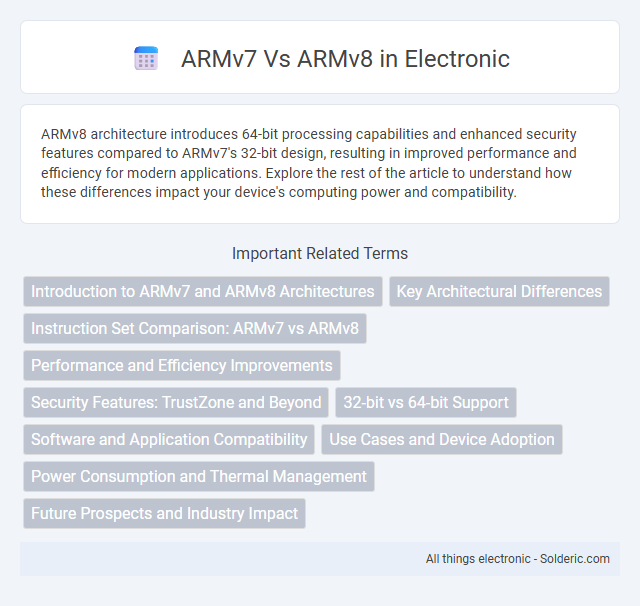ARMv8 architecture introduces 64-bit processing capabilities and enhanced security features compared to ARMv7's 32-bit design, resulting in improved performance and efficiency for modern applications. Explore the rest of the article to understand how these differences impact your device's computing power and compatibility.
Comparison Table
| Feature | ARMv7 | ARMv8 |
|---|---|---|
| Architecture | 32-bit | 64-bit and 32-bit (AArch64 and AArch32) |
| Instruction Set | ARM, Thumb-2 | ARMv8-A: A64, A32, T32 |
| Registers | 16 general-purpose registers (R0-R15) | 31 general-purpose 64-bit registers (X0-X30) |
| Performance | Moderate, suitable for legacy embedded systems | Improved performance, better power efficiency |
| Security Extensions | Basic TrustZone support | Enhanced TrustZone with Pointer Authentication (PAC) |
| Virtualization | Limited support | Advanced virtualization extensions |
| Cryptography | Optional NEON SIMD | Integrated cryptographic extensions |
| Use Cases | Smartphones, embedded devices (pre-2014) | Modern smartphones, servers, IoT, HPC |
Introduction to ARMv7 and ARMv8 Architectures
ARMv7 architecture, introduced in 2005, primarily supports 32-bit processing with enhancements in multimedia and real-time applications, widely used in smartphones and embedded systems. ARMv8 architecture, launched in 2011, introduced 64-bit processing capabilities along with improved security features like TrustZone and enhanced performance for mobile and server environments. Your choice between ARMv7 and ARMv8 depends on whether you require legacy 32-bit support or the advanced 64-bit processing and security improvements of ARMv8.
Key Architectural Differences
ARMv7 architecture is based on a 32-bit instruction set, while ARMv8 introduces a 64-bit instruction set, vastly improving processing power and addressable memory space. ARMv8 incorporates the AArch64 execution state alongside AArch32, enabling backward compatibility with ARMv7 software and enhanced performance with new instructions and a larger register file. The memory model in ARMv8 is more advanced with support for virtualization extensions, improved cryptographic capabilities, and enhanced exception handling compared to ARMv7.
Instruction Set Comparison: ARMv7 vs ARMv8
ARMv8 introduces a significant upgrade over ARMv7 by supporting both 32-bit (AArch32) and 64-bit (AArch64) instruction sets, whereas ARMv7 only supports 32-bit instructions. The ARMv8 instruction set enhances performance and security features, including improved cryptographic instructions and advanced SIMD (NEON) capabilities. ARMv8's instruction set also supports larger register files and streamlined encoding, enabling more efficient code execution and extended addressable memory.
Performance and Efficiency Improvements
ARMv8 architecture introduces significant performance and efficiency improvements over ARMv7 by incorporating a 64-bit instruction set that enhances processing power and memory addressing capabilities. Enhanced pipeline design and advanced power management techniques in ARMv8 reduce energy consumption while delivering higher throughput, making it ideal for modern high-performance and low-power devices. Your applications can benefit from faster execution speeds and improved multitasking capabilities due to these architectural advancements.
Security Features: TrustZone and Beyond
ARMv8 architecture advances security with enhanced TrustZone technology, offering improved isolation between secure and non-secure worlds compared to ARMv7. This evolution incorporates features like Pointer Authentication and Enhanced Memory Tagging to protect against modern attack vectors. Understanding these enhancements helps you develop more secure applications on ARMv8 platforms.
32-bit vs 64-bit Support
ARMv7 architecture supports only 32-bit processing, limiting its ability to handle large memory addresses and data widths. ARMv8 introduces 64-bit support with the ARMv8-A profile, enabling processors to access significantly larger memory spaces and improve performance in applications requiring extensive computational power. This shift from 32-bit to 64-bit architecture enhances overall system efficiency and future-proofs devices for advanced software requirements.
Software and Application Compatibility
ARMv7 supports 32-bit applications, making it compatible with a wide range of legacy software commonly used in embedded systems and mobile devices. ARMv8 introduces a 64-bit architecture that enhances performance and memory addressing capabilities while maintaining backward compatibility with ARMv7 32-bit applications. You can run most ARMv7 software on ARMv8 devices, but ARMv8's expanded instruction set allows developers to create more powerful and efficient applications optimized for modern computing demands.
Use Cases and Device Adoption
ARMv7 architecture is predominantly used in older smartphones, tablets, and embedded systems, supporting 32-bit applications ideal for cost-sensitive and low-power devices. ARMv8 introduces 64-bit processing, enhancing performance and security, making it the standard for modern smartphones, tablets, servers, and high-performance IoT devices. Your choice between ARMv7 and ARMv8 should consider device compatibility and performance needs, with ARMv8 favored for future-proof applications requiring advanced computing capabilities.
Power Consumption and Thermal Management
ARMv8 introduces advanced power management features, including enhanced idle states and dynamic voltage frequency scaling (DVFS), which reduce power consumption compared to ARMv7. The 64-bit architecture of ARMv8 allows more efficient processing, leading to lower thermal output and improved thermal management in devices. You can expect better overall energy efficiency and cooler operation with ARMv8-based processors, making them more suitable for modern mobile and embedded applications.
Future Prospects and Industry Impact
ARMv8 architecture introduces a 64-bit processing capability that significantly enhances performance and energy efficiency, positioning it as the foundation for future mobile, embedded, and server applications. Its support for advanced security features like ARM TrustZone and improved virtualization caters to evolving industry demands for secure and scalable computing. The widespread adoption of ARMv8 in modern smartphones, IoT devices, and data centers underscores its pivotal role in driving innovation and setting new standards in processor technology.
ARMv7 vs ARMv8 Infographic

 solderic.com
solderic.com